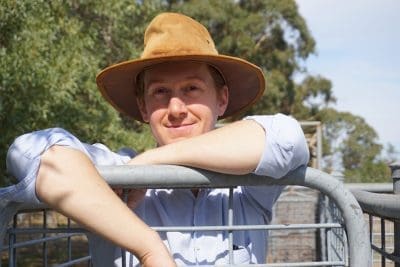WHILE domestic cattle prices have come off the boil, they are expected to still ‘simmer nicely’ during 2018, with producers forecast to enjoy a profitable year ahead, according to an industry report released today by Rabobank.
In its Australian 2018 Beef Cattle Seasonal Outlook, Rabo suggests the combination of increased cattle supply, reduced producer demand and weaker global prices will see domestic cattle prices ease back from the highs reached in 2017 to stabilise at just above five-year averages.

Angus Gidley-Baird
Supporting recent MLA forecasts, Rabo suggests cattle slaughter numbers will rise marginally and overall Australian beef production will increase by three percent for the year.
Report author, Rabobank’s senior animal proteins analyst Angus Gidley-Baird said while cattle price declines would more than offset the small rise in production – meaning producers’ incomes would generally be lower in 2018 – the outlook was still for an overall profitable 2018 for Australian beef producers.
‘Watch’ factors
Four ‘watch factors’ could however alter the shape of the year, and impact on the fortunes of Australia’s beef sector, both for better and for worse, the report cautioned.
These included the possibility of a big, early Queensland wet season in 2018-19, fierce competition in Asian export markets, rapid growth in Chinese demand for live exports and increased US cow slaughter.
Domestic cattle outlook
Mr Gidley-Baird said Australian beef production was forecast to rise slightly as the herd rebuild continues.
“After falling by 1.7pc to 7.16 million head in 2017, we expect cattle slaughter to rise slightly in 2018, with herd rebuilding over the previous two years in southern states now expected to start generating increased turnoff,” he said.
Also supporting MLA forecasts, the bank expects average slaughter weights – which have increased over the past three years as seasonal conditions have improved and the number of cattle on feed has increased – to remain high.
“We expect the number of cattle on feed to remain high and, with lower cow kill and heavier grassfed cattle weights due to the better seasons, this should result in an overall increase in production of 3pc,” Mr Gidley-Baird said.
Export markets
While Australia’s key beef export markets are expected to remain strong, competition was also increasing and would limit price upsides, the report said. With the forecast increase in Australian beef production, along with static domestic consumption, exports were set to rise slightly in 2018.
“Japan, the US, South Korea and China will remain key markets. However, we will see increased competition from other exporting nations in all these markets,” Mr Gidley-Baird said.
A softening Australian dollar, particularly in the second half of the year (Rabobank’s 12-month forecast is US75c) should at least assist Australia’s competitive position, he said.
Domestic price outlook
High cattle prices seen in 2017 had been driven by strong producer demand in a limited supply market, with producers looking to rebuild herd numbers or purchase cattle to consume available feed, the report said.
This had resulted in cattle price movements closely mirroring any changes in seasonal conditions. However, with stock numbers in southern states now nearing normal levels and the Queensland season on hold until the next wet season (hopefully) commences in October, producer demand is expected to ease in the market, enabling prices to fall back towards the five-year average and be less exposed to dramatic variation around rainfall events, Mr Gidley-Baird said.
The report forecasts 2018 domestic cattle prices to come in at 15pc below prior-year levels. The Eastern Young Cattle Indicator is expected to average 513c/kg for the year – just above the five-year average.
The report said two variables which could have a negative impact on the year ahead were fierce competition in Australia’s Asian markets, as well as the prospect of an increased US cow slaughter.
“Australia’s two key long-standing Asian export markets, Japan and South Korea, are also the key markets for US exports. And with increasing US production, Australia is already facing strong competition in these markets,” Mr Gidley-Baird said.
“The US has been undertaking promotional activities to encourage increased sales in both markets, and – while Australia has an advantage with the Japanese FTA – the US is two years ahead in tariff reductions with South Korea. If the US consumer’s appetite for beef wanes, greater volumes will be driven into these key export destinations, most likely at discounted prices.”
US beef production growth for the year had already been revised up from 3pc to 5pc (700,000t), the report said. A larger placement of cattle on feed and ongoing low feedgrain prices in the US has the potential to push carcase weights and production up further.
“Further, and more likely to have a bigger impact on Australia, are the dry conditions and lower cattle prices which could lead to a higher US cow slaughter in Q3 and lower demand for Australian lean trimmings by the US,” Mr Gidley-Baird said.
However, on the positive side, the report said, the possibility of a big, early Queensland wet season and the rapid growth in Chinese demand for live exports could have a favourable impact on the year ahead.
With a poor 2017/18 wet season, Queensland cattle producers (particularly those in central and western areas) had still not had enough of a season to confidently begin restocking. However, if a good, early wet season eventuates in 2018/19, producers looking to restock would drive cattle prices up, Mr Gidley-Baird said.
In the case of Chinese live export, Australia had sent the first load of live cattle by ship from northern Australia to China in January.
“If logistics, markets and supply chains are developed to allow such a trade to operate in large numbers on a regular basis, it will add competition for cattle in what is currently a supply-limited Queensland market – and it would drive live export and other cattle prices up,” he said.
Jump in cattle prices following rain
Meanwhile, the latest NAB Monthly Rural Commodities Wrap released today shows that on a state basis, cattle-heavy Queensland was the best performer, with farm commodity prices up 4.1 percent in March, compared with the previous month.

Phin Ziebell
NAB Agribusiness economist Phin Ziebell says cattle prices jumped following good rains across much of the state, but restocker interest hasn’t kept them there.
“The Eastern Young Cattle Indicator is now around 538c/kg, and by the end of the year we still see a fall to around the 500c range as likely,” Mr Ziebell said.
“Our view is that global trends, combined with expensive domestic feed grain and dry conditions in many areas, will see downward pressure on Australian cattle prices this year, although not by a large amount.”
The Index for wheat prices was up 2.4pc in March, and domestic wheat premiums remain.
“Lotfeeders will continue to need grain for some time to come, and after the disappointing summer crop, prices are likely to remain at a premium for now,” Mr Ziebell said.
“Barley prices are trading close to ASW levels due to the feed demand, which is a bonus for those with barley in storage.
“Looking ahead to the 2018-19 winter cropping season, the lack of subsoil moisture across major graingrowing districts of NSW, South Australia, Victoria and increasingly Western Australia leaves a lot of heavy lifting to be done by in-season rainfall.”
Mr Ziebell said the Australian dollar remained higher than what many producers would like.
“We have maintained our forecast that the dollar may move down to around US75c. For 2019, we see the A$ as hovering around the mid-70s. Of course, this forecast does not include the outbreak of a real trade war between the US and China – which would see a significantly lower A$.”
“China has already put a tariff on more than 100 US agricultural products. While there’s potential upside in some Chinese markets, such as horticulture, wine, and feedgrains, events are moving too fast to assess the full impact for agriculture at this stage.”
Looking at interest rates, going forward the RBA was likely to be very cautious. NAB has, however, maintained its view that two additional rate rises are likely in 2019.
Sources: Rabobank, NAB
